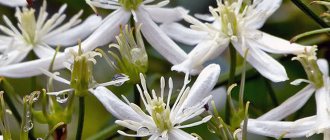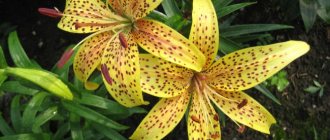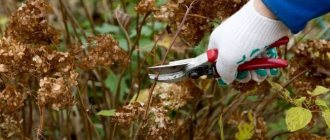Roses are a real decoration of any garden. A perennial flower crop requires careful care not only during the season, but also in the fall. Preparing for winter is a whole range of measures aimed at ensuring a comfortable winter for roses.
Dear readers! For you, we have created communities on social networks in which useful articles and interesting ideas are published several times a day! Subscribe and receive useful content in a convenient format!
In this article we will look at the basic rules for caring for flowers in the fall and preparing for wintering.
What does autumn rose care include?
Caring for roses includes a whole range of agrotechnical measures. They are aimed at ensuring that the flowers are fully prepared for the coming winter and, at the same time, laying the foundations for lush flowering next year.
During the preparation of roses in autumn:
- Trimmed;
- Treated against parasites and diseases;
- Feed with special organo-mineral fertilizers;
- Shelter from frost.
Each procedure has its own rules that must be followed.
Caring for roses in different autumn months
Preparing flowers for winter begins immediately after flowering ends. This is a long process that will allow the shrub to finish the growing season of the current year, gain strength before winter and spend the coldest months of the year in comfort.
Let's consider what kind of care flowers need to be provided in each of the autumn months.
Roses in September
In the first autumn month, they stop picking flowers from the bush so as not to allow the growth of new inflorescences.
By the end of the month we need to stop watering, so throughout September we gradually reduce it. Stick to the norm of 1 watering per week, then 1 watering every 2 weeks.
Instead of nitrogen fertilizers, we introduce potassium and phosphorus-containing preparations into the diet. After fertilizing, do not forget to loosen the soil.
Flowers are usually pruned at the end of the month.
Roses in October
If in September after fertilizing it was necessary to loosen the soil, then in October there is no need to do this.
This month we no longer water the plant, and we carry out the last feeding in the second decade.
Plant care at this time also includes sheltering the plants from possible rain. And don’t forget about treating diseases and pruning bushes.
ON A NOTE. If you were going to move the bush to a new place, then October is the most suitable month for this.
Roses in November
In November, flowers are covered by residents of warmer regions. Before the shelter, the rose garden is dug up and hilled. Next, a shelter is built, and if necessary, a half-meter mound of earth is poured onto the root.
Transplanting roses
It is best to replant roses in September - the first ten days of October. First of all, it is necessary to transplant bushes that, for whatever reason, are developing poorly, to a new location. New purchased roses are also planted in a suitable place in the fall. When transplanting rose bushes, you should follow certain rules:
- Choose a place on the site that is open and sunny.
- To plant roses, you must first prepare the holes. If there are a lot of bushes, make markings. A distance of 40-50 cm is made between small roses. Varieties of bush and climbing roses are planted at a distance of 1-1.5 meters between shoots. The holes are usually made in size - 50x50 cm.
- For transplantation you also need a nutrient mixture. To prepare it, take compost, peat and sand in equal quantities. You can add clay to the soil for the flower. It is recommended to add ash, bone meal and other nutritional elements to the resulting mixture.
- Before transplanting, seedlings need to be soaked. Then they are lowered into the hole, straightening the roots. After this, the hole is filled with soil and watered generously. When the water is completely absorbed into the ground, the bushes are spudded.
Important! The best time to replant roses is the end of October. First, the roots of the seedlings are shortened a little and holes of 50x50 cm are formed. The soil mixture is added to the prepared hole. After planting, roses are watered generously.
The rose should be replanted if it does not respond well to care in the warm season. You need to dig up a bush for replanting very carefully. The roots are then wrapped in natural fabric for storage or safe transportation. Before planting, the branches are cut by 2/3. A bush is placed in the prepared hole, the roots are straightened and covered with fertile soil.
How to take rose cuttings
Rose cuttings are cut as follows:
- Choose healthy mature shoots with a diameter of 4-5 mm.
- Cut them into small pieces so that each has 3-5 developed buds.
- The upper cut is made straight 2-3 cm above the upper bud, and the lower cut is made obliquely under the lower bud, so that you know which part to plant the cutting.
- For cutting, use a sharp instrument, which is disinfected with alcohol and boiling water.
Advice! When rooting a rose, there is no need to immediately remove the leaves; they will provide nutrition to the plant; only the lower leaves are removed.
Planting a rose from a cutting
After cutting, the cuttings are planted in a permanent place. This method is preferable, as the plant experiences less stress and takes root better. Autumn rooting of rose cuttings is carried out as follows:
- The cuttings are cut and treated with a root former (for example, Heteroauxin).
- Dig a hole 30 cm deep, fill 2/3 with grass and sprinkle with compost.
- The cuttings are planted at an angle of 45 degrees, leaving 1/3 of the shoot or 1-2 buds above the ground.
- Fill the hole and water it abundantly.
- How to cover rose cuttings for the winterSo that the planted cuttings survive until spring, they are covered with a plastic bottle in which several holes are made for air circulation. You can use a glass jar, then it needs to be raised slightly above ground level. Everything is sprinkled with leaves on top and covered with non-woven material. Pegs are driven in nearby to mark new plantings.
How to save rose cuttings in winter
If you plan to plant cuttings in the spring, then you need to take care of their safety in the winter. They do it like this:
- Dig a hole 15 cm deep in the garden, lay a covering woven material on the bottom, and lay cuttings without leaves on top at the same distance from each other. Pegs are driven in along the edges of the hole so as not to forget their location.
- Cover everything with the remaining cloth and sprinkle with soil.
- In the spring, when the snow melts, the cuttings are dug up and examined. On the “established” ones, callus appears - a thick growth on which roots are formed.
- The shoots are immediately planted in the cuttings or in a permanent place.
- If planting will take place in a day or more, the cuttings are placed in a container of water (it is better to add a few drops of Epin to it).
Preparing roses for winter in different regions
Let's consider whether there are any features of caring for and preparing flowers for winter in different Russian regions.
Middle lane
In Central Russia, the last feeding of flowers is carried out at the end of September - beginning of October. Then the bush is trimmed. The rose garden must be covered by the end of October. But, if autumn is warm, then this procedure can be postponed until the first days of November.
Ural
In the Urals, the main activities for plant care in the fall are shifted. Thus, it is advisable to carry out pruning before the end of summer, and insulate the bushes before the end of September.
ON A NOTE. The Urals have harsh winters, so it is advisable to cover the covered rose garden with snow.
Siberia
Caring for and preparing roses for winter in Siberia is no different from the Urals. Here, in the same way, the plant is pruned at the end of August, and insulated at the end of September - early October.
Leningrad region
In North-West Russia, fertilizing and pruning are carried out in September. Sheltering activities take place in the first ten days of October.
Events in September
Previously, preparing roses for winter started in the first ten days of September. In recent years, there has been a trend towards warmer weather in the first month of autumn, and the main events have now shifted to the second half of the month.
Loosening
Loosening is an essential component when growing this crop. Getting rid of the crust on the ground ensures good air exchange in the upper parts of the root system, reduces drying out of the soil and helps remove unwanted weeds. In the first half of September, loosening is carried out in the standard mode a few days after watering.
From the third ten days of September, loosening stops, as this activates the “dormant” buds in the lower parts of the branches to continue growth. The lack of loosening prepares the bush for winter conditions and slows down its natural processes.
Removing flowers and trimming
To ensure that the bush does not waste excess potential on ripening seeds, but redirects it to the formation of new buds, withered flowers are immediately removed throughout the flowering period. This principle changes dramatically with the onset of September. In the second half of the month, there is no rush to remove faded inflorescences, otherwise new buds will continue to appear on the rose bushes.
Refraining from pruning allows the stem to ripen completely. As the seeds ripen, natural autumn processes will occur in it, which will prepare it for cold weather: plant sugars will move from the foliage to the stems, which will protect the cell sap from freezing and rupture during severe frosts.
Watering
In order for the crop to gradually move from active mode to dormancy, it is necessary to change the intensity of watering. At high temperatures, it is carried out in summer volumes, but as temperatures begin to decrease, moisturizing becomes more moderate.
A slight lack of watering slows down the growth rate of branches and the formation of new inflorescences. It is also useful for the root system, which tolerates critical temperatures in dry soil much better than in the presence of moisture.
Top dressing
The application of fertilizers when growing these plants plays a key role in the flowering and well-being of the crop. No less important is the feeding regime in preparation for winter.
The main purpose of fertilizing in the fall is to increase frost resistance. Complexes based on phosphorus and potassium with a low nitrogen content have this effect to a large extent. In autumn feeding, each of these elements plays its role:
- Potassium. Participates in the chemical transformation of monosaccharides into polysaccharides. This is a very important process, since it is polysaccharides that protect cell sap from crystallization and freezing. With the help of potassium compounds, nutrients from leaf blades are transported to storage organs, and the cell walls become thicker, so fungi cannot penetrate through them.
- Phosphorus. This substance is also involved in the synthesis of sugars and regulates water metabolism. The presence of phosphorus forces, on the eve of winter, those structures that would freeze out if there was a deficiency.
Nitrogen is also very important at the stage of preparation for winter, but due to the fact that it takes a long time to transform, and the need for it during the fall is very small, nitrogen reserves are sufficient from the summer, so it is no longer necessary to apply additional nitrogen fertilizers from September.
To prepare a nutrient solution in mid-September you will need:
- superphosphate – 100 g;
- potassium sulfate – 30 g.
They dissolve in 10 liters of settled or softened water. The application rate is 1 bucket per bush. Some gardeners recommend not using a solution with water after rain, but mixing these two dry components and embedding them around the plant in wet soil.
At the end of September, another exclusively potassium replenishment is carried out. To do this, dilute 30 g of potassium sulfate or 15 g of potassium magnesia in 10 liters of water. This volume is sufficient for one adult or two young bushes.
When to fertilize roses in autumn
Before winter, it is necessary to change the plant’s diet.
Firstly, nitrogen fertilizing is cancelled. Nitrogen is necessary for the growth of green mass and shoot growth. There is no need for this in the fall.
Secondly, they increase the amount of potassium, phosphorus and magnesium. These are three elements that strengthen the root system of the bush. Also, thanks to them, the shoots become woody. It is allowed to use both dry granular fertilizers and liquid preparations.
Ideally, the rose should be fed several times in three different ways:
- At the beginning and end of September, apply liquid fertilizer. It is prepared from 10 liters of water, 1 tablespoon of potassium sulfate, 2 tablespoons of superphosphate and half a teaspoon of boric acid.
- From the beginning of autumn until the Intercession, a spraying composition is used. For 10 liters of water you need 1 teaspoon of potassium monophosphate and the same amount of superphosphate.
- In dry form, fertilizing is applied until mid-October. Before covering the roses, scatter potassium magnesium granules over the soil and embed it into the soil. Instead of potassium magnesium, you can use wood ash.
Top dressing
The time to feed the plant comes 2 weeks after pruning.
Important! Nitrogen fertilizers do not need to be added to the soil from the moment the rose begins to bloom until the end of the season. The fact is that after this feeding, active growth of green mass begins.
With the arrival of autumn, rose bushes are nourished with fertilizers such as:
- phosphorus;
- magnesium;
- potassium
They are necessary in order to strengthen the roots and young shoots of the crop before the onset of frost. In addition, they help restrain the development of the aboveground part of the plant.
To prepare fertilizer for 1 bucket of water take:
- Potassium sulfate, magnesium sulfate – 10 g each.
- Superphosphate - 25 g.
- Boric acid – 2.5 g.
The prepared solution is poured under the bush only after the soil around it has been thoroughly watered. A bucket of fertilizer solution is enough for 3-4 square meters. landing
For foliar feeding, the following components are required:
- for 3 buckets of water;
- potassium monophosphate -15g;
- superphosphate - 15 g.
On the 7th day after fertilizing, pinch the tops of the shoots so that the stems become woody faster.
Dry feeding
Today, many gardeners prefer to feed garden crops with folk remedies. Basically, two such remedies are used in the fall:
- wood ash, rich in potassium and phosphorus;
- banana peel, which is previously dried and ground into powder.
The soil under the bush is sprinkled with dry ash powder, but you can dilute it in water and pour the solution onto the ground.
Banana peels can be dried and crushed at home In this form they are mixed with the soil under the rose bushes. Fresh banana peels can also be used to feed the plant. In this case, it is buried in the root in early September. Before winter comes, the fruit waste will have time to rot.
Using these products, you can use a combined method of feeding roses.
Important! So that the last fertilizer is applied before the beginning of October, and in cold regions - until mid-September.
Potassium magnesium in the form of granules is used as this feeding and at the same time for disinfection. The soil around the roses is sprinkled with this product before covering the plant, in October-November.
Pruning roses in autumn, features of the procedure
Pruning in the fall serves several purposes:
- Shrub rejuvenation;
- Sanitary and preventive treatment;
- Decorative formation of a bush;
- Helping the bushes during wintering.
REFERENCE. Pruned roses tolerate frost several times better. Therefore, it is very important to prune in the fall.
The shoots must be trimmed using sharp pruning shears, which must first be disinfected with alcohol. Remember, the neater the cut, the faster it will heal.
All cuts should be made at an angle of 45 degrees. This is not necessary for decorative purposes, but to prevent liquid from accumulating in the shoots and causing infection.
The cut is made no higher than 1 cm above the swollen, but not sprouted bud.
There is no need to delay the procedure. The bush needs some time for the cuts to heal. Therefore, pruning is carried out at the end of September - beginning of October.
BY THE WAY. In the fall, shoots can be trimmed “with a reserve”, and in the spring they can be shortened to the desired length. This is done so that in the event of a very harsh winter and the shoots freeze, the rose still has buds that can grow back.
Trimming
To work with rose bushes, it is recommended to choose a clear day without wind or rain.
- Flower growers living in cold climates (Siberia, the Urals, St. Petersburg) prune roses in the second ten days of October.
- In central Russia, such work can begin at the end of October.
- In the southern regions, for example, in Kuban, this event can be postponed until early November.
It is very important to prune roses at air temperatures from -2 ْ to -4 ْС, not higher. The fact is that pruning itself pushes the plant to begin development. Young buds may begin to grow on the eve of frost, which will lead to disease or death of the bush. After pruning, the bushes need to be properly insulated to create good conditions in winter.
Correctly carried out procedures will provide the plant with increased frost resistance. Pruning old branches will give impetus to the development of young shoots in the spring. In addition, the buds will be larger.
It is necessary to treat not only adult plants, but also young bushes of the first year of life. This procedure should be carried out for all plants annually in the fall. But, there are types of roses that do not require pruning.
Pruning rules
There are some rules for pruning roses in the fall. These should be followed to get a high-quality plant with many buds:
- The shoots are cut at an angle of 45 degrees.
- Dry, diseased, pest-damaged shoots are removed.
- All unripe shoots are also removed.
- For work, you should use only a sharp and clean knife so as not to injure the plant.
Important! Immediately after pruning, the cut sites are treated with wood ash or any antiseptic. This will help reduce the risk of infection by harmful microorganisms.
Pruning for different types of roses
Depending on the type of rose, its size and intensity of development, you can choose the type of pruning in the autumn:
- Short (strong) pruning - the length of the branches is about 5-10 cm. They are practically cut off completely, leaving only 2-3 buds near the ground on each shoot.
- Medium (moderate) - the length of the branches is about 30-40 cm. When pruning the shoots, 5 buds are left from the ground. Dry and diseased branches are removed. With the arrival of spring warmth, the rose produces a lot of young shoots.
- Long (light) - branches 70-100 cm. Here, pruning is carried out only at the tips of the branches, on which at least 10 buds should remain.
Watch the video! How to prune roses for the winter and cover them
Features of pruning different types of roses
- In climbing rose , for example, in the Rambler variety, which bloom with small flowers, only the tips of the branches are cut off. Climbing types of roses with large flowers remove all faded stems, but leave 2-3 shoots from last season. The side shoots are cut off, leaving 10 cm, which should have 2-3 buds.
- The polyanthus type of roses is famous for its enhanced growth and lush flowering. Old and immature branches of the plant are cut off, and all the rest are shortened, leaving 3-4 buds on each. In polyanthus roses with small flowers, 2-3 buds are left when trimming strong shoots, and on weak shoots - up to 1-2 buds. This treatment promotes better development of the bush and active flowering.
- Hybrid tea roses do not require heavy pruning, as this may result in the development of new shoots without flowers. Therefore, when pruning, stems up to 30 cm in length with 5 buds are preserved. However, this type of pruning also does not lead to massive flowering of the bush.
Advice! If flowers appear on the top of the branches, but the lower part of the bush does not bloom, then you need to cut off all the old shoots and trim the rest short.
- Medium pruning in autumn is also carried out for such types of roses as grandiflora and remontant ones.
- The Pernetian rose variety is in many ways similar to the hybrid tea variety. In one and the other plant, flowers are formed at the ends of the shoots of one year of life. Therefore, in the autumn, they trim a third of the growth. Dry and damaged parts of the plant are cut off completely.
- Before planting, all branches of cascading standard roses are cut short to 15 cm from the ground. The next year and with each subsequent year, the old branches are cut shorter and shorter. The young shoots are left, slightly shortened.
- Floribunda roses have the ability to quickly grow to large sizes. For such branched plants, combined treatment of the bush is used. Half of the stems are cut short, the other half is shortened medium. The remaining side shoots are cut off, leaving only 2-3 buds on the shoot.
- Park roses undergo light pruning, leaving about 8-10 young buds on the stems. The same method is used for pruning rose varieties such as Bengal, English, and hybrid tea roses with large flowers. For Old English species and bush roses, the stems are cut back by two-thirds.
- Climbing roses , which can be divided into those that bloom once and repeatedly, require a special approach to such a procedure as pruning. So, the first ones form buds on last year’s branches. In autumn they are cut off, leaving young shoots. The latter produce buds on the main stems for three seasons, and in the fourth year, for the winter period . At the same time, be sure to leave 4-6 strong and healthy stems that are still capable of blooming.
Ground cover rose varieties are not pruned in the autumn. In order to sanitize the bushes, it is enough to remove old, damaged and dry branches. It is recommended to cut off all branches once every few years, leaving stumps up to 15 cm from the ground.
Preparing climbing roses for winter
For climbing roses, it is very important to carry out proper preparation for winter, since this type of plant has “forgot how” to go into dormancy on its own.
This means that it is imperative to cancel watering and eliminate nitrogen fertilizers.
Pruning is also required, during which all damaged, dry and youngest shoots must be cut off. The rest are only slightly shortened.
IMPORTANT! All leaves and even petioles are torn off from climbing roses.
And don’t forget to bend the shoots to the ground and cover them. This is an important part of autumn care.
Nuances of autumn watering and fertilizing
In autumn, watering roses is sharply reduced, and from the last ten days of September they should be stopped completely. In this case, the growth of shoots and foliage of the perennial will practically stop, and in the shrub itself the process of preparing for a state of dormancy will begin.
Photo of watering roses
If the rainy season begins at the beginning of autumn, then the “queens of flowers” should be protected from unnecessary moisture. For this purpose, you need to stretch transparent polyethylene over the rose garden, and dig narrow trenches around the bushes, with the help of which excess water will drain away from the rose garden.
Also in the autumn, these flowering perennials need fertilizers of a certain composition.
BEAUTIFUL VARIETIES OF ROSES!
Hybrid tea rose Princess of Monaco Floribunda rose Stromboli Chic American - Abracadabra
Important! In autumn, fertilizers containing nitrogen should not be used to feed rose bushes. This mineral element is very useful for these shrubs in spring and early summer, as it stimulates the active growth of the vegetative mass of the perennial. But in the fall, such stimulation is extremely dangerous - the growing stems and foliage will weaken the bush and take away nutrition from the root system and woody shoots, which need to gain strength before the oncoming frosts. In addition, the stems that begin to grow in the fall will not have time to grow stronger before winter and will freeze out during the cold period.
Photo of applying fertilizer for roses
In autumn, plants require potassium, magnesium and phosphate fertilizers.
They can be used dry and scattered in the circles of rose bushes. Such fertilizing should be carried out no later than the last ten days of September - the first ten days of October.
Before fertilizing roses in the fall, the soil should be loosened, after applying fertilizers, watering is carried out and the soil is loosened again to incorporate nutrients into the soil.
How to water roses correctly - video
Treatment of roses in autumn
Autumn is a great time to treat roses for diseases.
You can use different drugs, but it is necessary to take into account their characteristics.
For example, Fitosporin can only be used until mid-September, since it does not work in cold weather. Treatment with this product is carried out 3 times in 2 weeks from mid-August to mid-September.
When black spots appear on the leaves, use Ridomil Gold. The plant is sprayed with this drug once a week throughout the month.
The most effective are preparations such as iron and copper sulfate, Bordeaux mixture, as well as copper-based products (Hom, Oxychom, etc.).
IMPORTANT! The working solution must be prepared exclusively in accordance with the attached instructions.
How to treat roses before winter?
In autumn, you should use drugs that work at low temperatures, such as Horus. This is a universal fungicide with both contact and systemic effects. They can be used to process many crops in the garden - roses, shrubs, and fruit trees. It affects many pathogens of spotting, rot, and even moniliosis, which has become widespread in recent years on many stone fruit and fruit crops.
You can use copper-containing preparations for pre-winter treatment of roses, for example Khom, Copper sulfate, Oksikhom, Bordeaux mixture. You can also use iron sulfate.
When to cover roses for the winter
You need to cover your roses before it gets cold. Depending on the region, this is the end of September - mid, end of October.
Shelter is the most important stage in preparing a plant for winter. If you make a mistake here, the bush simply will not survive the winter.
The best option to cover the bushes is to make an air-thermal structure: agrofibre on a rigid frame made of boards. Such a shelter will prevent the plant from freezing and, at the same time, ensure normal air circulation, and the rose will not rot.
IMPORTANT! The film does not allow the bush to breathe, so damping off may begin.
You can also cover roses in the fall with spruce branches, straw, burlap and halves of plastic bottles with holes for ventilation.
Common mistakes
- Using film as a covering material. The film does not allow air to pass through, which is why the bush begins to rot during thaws.
- Fertilizing with nitrogen fertilizers. Before winter, potassium-phosphorus compounds are used, and nitrogen is excluded from the diet.
- There is no autumn care. The rose does not undergo any preparation at all before wintering.
- Rose doesn't hide. The bush does not shelter, which is why the shoots freeze.
- Watering continues until the shelter. Watering the shrub must be stopped in advance to slow down the plant's growing season.
- The plant is pruned too much. There is no need to shorten the shoots too much. This way the rose will survive the winter worse.
- No fungicide treatment. Spraying with fungicidal compounds will destroy most pathogenic microorganisms.
Answers to frequently asked questions
What care does a rose need in autumn?
Pruning, treatment for diseases, fertilizing and construction of shelter for the winter.
Do I need to feed shrubs in the fall?
Yes, plant care includes, among other things, feeding. But it must be done before the shelter, so that the fertilizers decompose and begin to act.
Why do roses need to be pruned in preparation for winter?
There are several reasons: for sanitary purposes, for the formation of a bush, for rejuvenation, so that the rose can better withstand the winter.
Preparations in November
The first frosts and even snowfalls may occur this month. If the month occurs without abnormal temperature fluctuations, then preparations for winter should proceed according to the standard scheme.
Hilling
Hilling work is carried out only on days when no precipitation is expected. The first hilling occurs in early November. First, you need to remove all weeds from the root zone, after which you carefully loosen the soil to a depth of 4-5 cm, trying not to damage the roots.
To avoid the spread of infectious agents, the soil around the bushes in the tree trunk area is treated with Bordeaux mixture or copper sulfate. After this, the plant is covered with earth so that it does not suffer during the first significant drop in temperature.
In mid-November, hilling is repeated, only compost or humus is used for this. Experienced gardeners advise pouring a thin layer of ash on top.
Hilling roses with sawdust or sand is not recommended, since these materials are very hygroscopic and can provoke the development of rot in the cervical area.
Dropping
All branches and shoots that can be buried must be bent to the ground, pinned with special pegs and covered with dry soil on top. This method is much more effective than covering, because after it the stems begin to vegetate much faster in the spring and form stronger foliage. Digging allows you to prune the bushes less in order to preserve the vegetative mass for the next season.
This method is well suited for climbing, semi-climbing and climbing roses.











